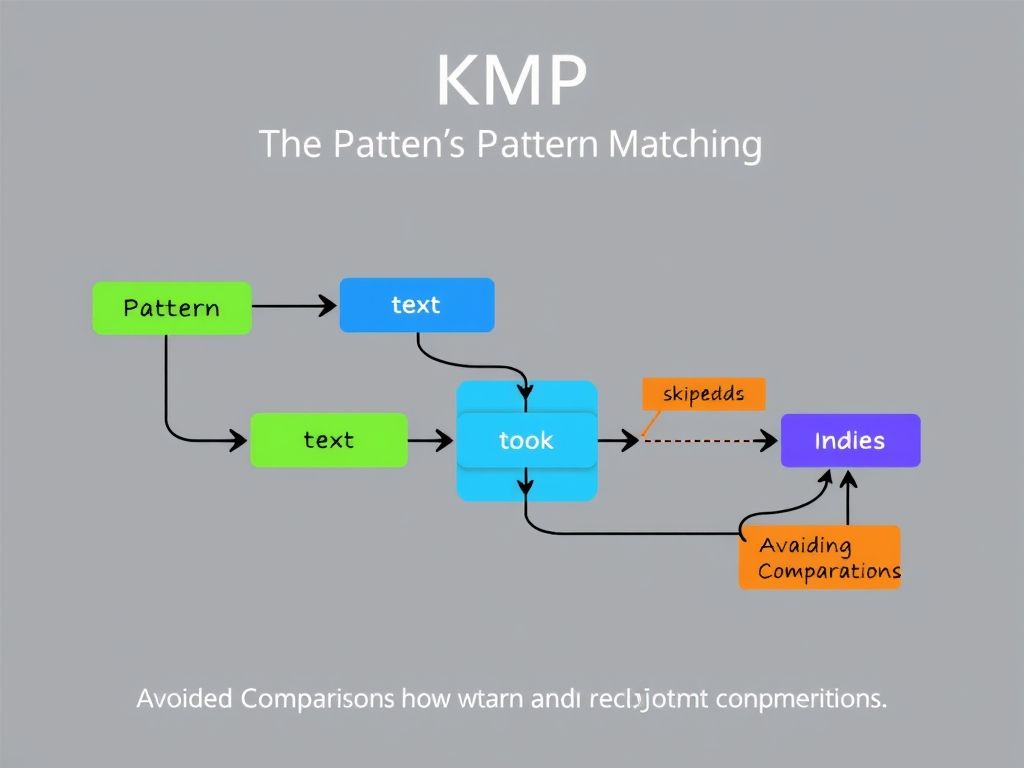String algorithms are fundamental in computer science, enabling tasks from searching for specific patterns in text to complex data analysis. This article delves into the world of string processing, focusing on powerful techniques like the KMP algorithm and string search, equipping you with the knowledge to handle various string manipulation challenges effectively.
Chapter Title: Introduction to String Processing Algorithms
String processing algorithms are fundamental tools in computer science, playing a crucial role in a vast array of applications. From the everyday task of text editing to complex data analysis and sophisticated pattern recognition, these algorithms enable us to manipulate, analyze, and extract meaningful information from textual data. The efficiency and effectiveness of these algorithms directly impact the performance of many software systems.
One of the core challenges in computer science is efficiently searching for patterns within larger texts. This is where algorithms like the Knuth-Morris-Pratt (KMP) algorithm and various string search algorithms come into play. They provide optimized solutions for locating specific sequences of characters within a given string, a task that arises frequently in numerous contexts.
Consider the simple example of a text editor. When you use the “find” or “search” function, you’re relying on a *string search algorithm* to locate the text you’re looking for within the document. Similarly, in data analysis, you might need to identify specific keywords or phrases within a large dataset of text documents. This process often involves employing sophisticated **thuật toán xử lý chuỗi** (string processing algorithms) to efficiently extract relevant information.
In the realm of bioinformatics, string processing algorithms are essential for analyzing DNA sequences. These sequences can be represented as strings of characters, and identifying specific patterns within these strings is crucial for understanding genetic information and developing new treatments for diseases. The **KMP** algorithm, for example, can be used to quickly identify specific gene sequences within a large DNA strand.
Another critical application area is network security. Intrusion detection systems often rely on string processing algorithms to identify malicious patterns in network traffic. By searching for known attack signatures within the data stream, these systems can detect and prevent security breaches. The ability to rapidly identify these patterns is paramount in maintaining network security.
The naive approach to string searching involves comparing the pattern to every possible substring of the text. However, this method can be inefficient, especially when dealing with large texts and complex patterns. The **KMP** algorithm offers a significant improvement over this naive approach by avoiding redundant comparisons. It achieves this by pre-processing the pattern to identify repeating sub-patterns, allowing it to “jump” ahead in the text when a mismatch occurs. This optimization can dramatically reduce the search time, especially for patterns with internal repetitions.
The importance of efficient **thuật toán xử lý chuỗi** extends beyond these specific examples. They are also used in:
- Compiler design: For lexical analysis, where the source code is broken down into tokens.
- Database systems: For indexing and searching text-based data.
- Search engines: For indexing web pages and retrieving relevant results.
- Spam filtering: For identifying spam emails based on specific keywords or patterns.
The ability to process strings efficiently is therefore a cornerstone of modern computing. Understanding the principles behind these algorithms and their applications is essential for any computer scientist or software engineer. *The choice of which algorithm to use depends heavily on the specific application and the characteristics of the data being processed.*
In summary, string processing algorithms, including the **KMP** algorithm and other **tìm kiếm chuỗi** (string search) methods, are indispensable tools for a wide range of applications. They enable us to efficiently manipulate, analyze, and extract information from textual data, playing a crucial role in fields as diverse as text editing, data analysis, bioinformatics, and network security. Their efficiency and effectiveness are paramount in ensuring the performance and reliability of many software systems.
Understanding the KMP Algorithm
Chapter 2: Understanding the KMP Algorithm
Building upon the “Introduction to String Processing Algorithms,” where we established the significance of string manipulation in diverse fields like text editing and pattern recognition, we now delve into a powerful tool for efficient string search: the Knuth-Morris-Pratt (KMP) algorithm. The previous chapter highlighted the challenges of naive string search methods and how algorithms like KMP aim to overcome these limitations.
The KMP algorithm stands as a cornerstone in the realm of thuật toán xử lý chuỗi (string processing algorithms). Its core strength lies in its ability to perform pattern matching without repeatedly backtracking in the text being searched. This makes it significantly faster than simpler, more intuitive approaches, especially when dealing with large texts and complex patterns.
At its heart, the KMP algorithm is designed to find occurrences of a “pattern” within a larger “text.” Unlike a naive search, which might shift the pattern by only one position after a mismatch, the KMP algorithm leverages information gleaned from previous comparisons to make more intelligent shifts. This is achieved through the use of a precomputed “prefix table” or “failure function.”
The key idea behind the KMP algorithm is to avoid redundant comparisons. Consider a scenario where you’re searching for the pattern “ABABACA” in a text. If a mismatch occurs at the last ‘A’ of the pattern, a naive approach would shift the pattern by one position and start the comparison again from the beginning. However, the KMP algorithm recognizes that the prefix “ABA” of the pattern is also a suffix of the portion of the text that has already been matched. Therefore, it can shift the pattern further, aligning this common prefix and suffix, and resume the comparison from that point. This intelligent shifting avoids unnecessary re-examinations of the text.
The prefix table, often denoted as `pi`, stores the length of the longest proper prefix of the pattern that is also a suffix of the pattern’s prefixes. For example, for the pattern “ABABACA”, the prefix table would be constructed as follows:
* `pi[0] = 0` (No proper prefix for “A”)
* `pi[1] = 0` (No proper prefix of “AB” is also a suffix)
* `pi[2] = 1` (“A” is both a prefix and suffix of “ABA”)
* `pi[3] = 2` (“AB” is both a prefix and suffix of “ABAB”)
* `pi[4] = 3` (“ABA” is both a prefix and suffix of “ABABA”)
* `pi[5] = 0` (No proper prefix of “ABABAC” is also a suffix)
* `pi[6] = 1` (“A” is both a prefix and suffix of “ABABACA”)
This table allows the algorithm to determine how far to shift the pattern in case of a mismatch. The time complexity for constructing the prefix table is O(m), where m is the length of the pattern. The KMP search itself has a time complexity of O(n), where n is the length of the text. Thus, the overall time complexity of the KMP algorithm is O(m + n), which is a significant improvement over the O(m*n) complexity of the naive tìm kiếm chuỗi (string search) approach.
The advantages of the KMP algorithm over naive string search are numerous. Its optimized shifting mechanism dramatically reduces the number of comparisons needed, making it particularly effective for large datasets and repetitive patterns. It guarantees a linear time complexity, ensuring predictable performance even in worst-case scenarios.
The KMP algorithm finds applications in a wide range of real-world scenarios:
* Bioinformatics: Searching for specific DNA sequences within a genome.
* Text editors: Implementing “find and replace” functionality.
* Network security: Detecting malicious patterns in network traffic.
* Data compression: Identifying repeating patterns for efficient data storage.
*Understanding the nuances of the KMP algorithm, particularly the construction and utilization of the prefix table, is crucial for mastering string processing techniques.* Its elegance and efficiency make it a fundamental tool for any programmer working with text-based data.
Having explored the KMP algorithm in detail, the next chapter will broaden our horizons by examining other advanced string search techniques, comparing their strengths and weaknesses, and discussing the factors that influence the choice of the most appropriate algorithm for a given task. This will set the stage for a deeper understanding of the multifaceted world of string processing.
Here’s the chapter content:
Advanced String Search Techniques
Having explored the Knuth-Morris-Pratt (KMP) algorithm in the previous chapter, which significantly optimizes the naive string search approach, we now delve into other advanced string search algorithms. These techniques offer varying trade-offs in terms of performance, memory usage, and suitability for different types of patterns and text. This chapter will compare and contrast several prominent algorithms, focusing on their strengths and weaknesses, and discuss how choosing the right algorithm impacts performance and resource usage in specific scenarios related to tìm kiếm chuỗi.
One notable algorithm is the Boyer-Moore algorithm. Unlike the KMP algorithm, which scans the text from left to right, the Boyer-Moore algorithm typically scans the pattern from right to left. This allows it to potentially skip large portions of the text, especially when the pattern contains characters that are not present in the current text window. The Boyer-Moore algorithm employs two key heuristics: the “bad character” heuristic and the “good suffix” heuristic. The bad character heuristic shifts the pattern based on the mismatched character in the text, while the good suffix heuristic shifts the pattern based on the matched suffix. *The combination of these heuristics often results in sublinear time complexity in practice, making it highly efficient for searching large texts with relatively short patterns.* However, its worst-case time complexity can still be O(m*n), where n is the length of the text and m is the length of the pattern.
Another significant algorithm is the Rabin-Karp algorithm. This algorithm uses hashing to find matches. It calculates a hash value for the pattern and then slides a window of the same length across the text, calculating the hash value for each window. If the hash values match, it performs a character-by-character comparison to confirm the match. The efficiency of the Rabin-Karp algorithm depends heavily on the choice of the hash function. A good hash function should distribute strings evenly across the hash space to minimize collisions. *The advantage of the Rabin-Karp algorithm is its simplicity and its suitability for multiple pattern searching.* It can efficiently search for multiple patterns simultaneously by pre-computing the hash values for all the patterns.
Aho-Corasick algorithm is another powerful technique especially useful for searching multiple patterns simultaneously. It builds a finite state machine (FSM) from the set of patterns. The FSM consists of a trie representing the patterns, augmented with failure links. The algorithm processes the text by traversing the FSM. When a match is found, it reports the matching pattern. *The Aho-Corasick algorithm has a time complexity of O(n + m + z), where n is the length of the text, m is the total length of all patterns, and z is the number of occurrences of the patterns in the text.* This makes it very efficient for searching for a large number of patterns in a single pass.
Comparing these algorithms, the KMP algorithm provides a guaranteed linear time complexity of O(n+m), making it suitable when worst-case performance is critical. The Boyer-Moore algorithm, while having a worst-case complexity of O(m*n), often performs much better in practice, especially with longer patterns and diverse character sets. The Rabin-Karp algorithm is simple to implement and can be efficient with a good hash function, particularly for multiple pattern searching. The Aho-Corasick algorithm excels at searching for a large set of patterns simultaneously.
The choice of algorithm depends on the specific application. For example, in text editors where responsiveness is paramount, the Boyer-Moore algorithm might be preferred due to its typical sublinear performance. In network security applications where a large number of signatures need to be matched against network traffic, the Aho-Corasick algorithm would be more appropriate. Understanding the trade-offs between these algorithms is crucial for efficient thuật toán xử lý chuỗi. Considering the properties of the text and patterns allows for informed decisions that optimize performance and resource usage. The KMP algorithm remains a foundational technique, but these advanced algorithms offer valuable alternatives for specialized scenarios.
In the next chapter, we will explore string matching with regular expressions and how they provide a flexible way to define complex patterns.
Conclusions
String algorithms are crucial for efficient data processing. By understanding KMP and other search techniques, you can optimize your code and solve complex string-related problems effectively. Further exploration of these algorithms will lead to more efficient and robust applications.











